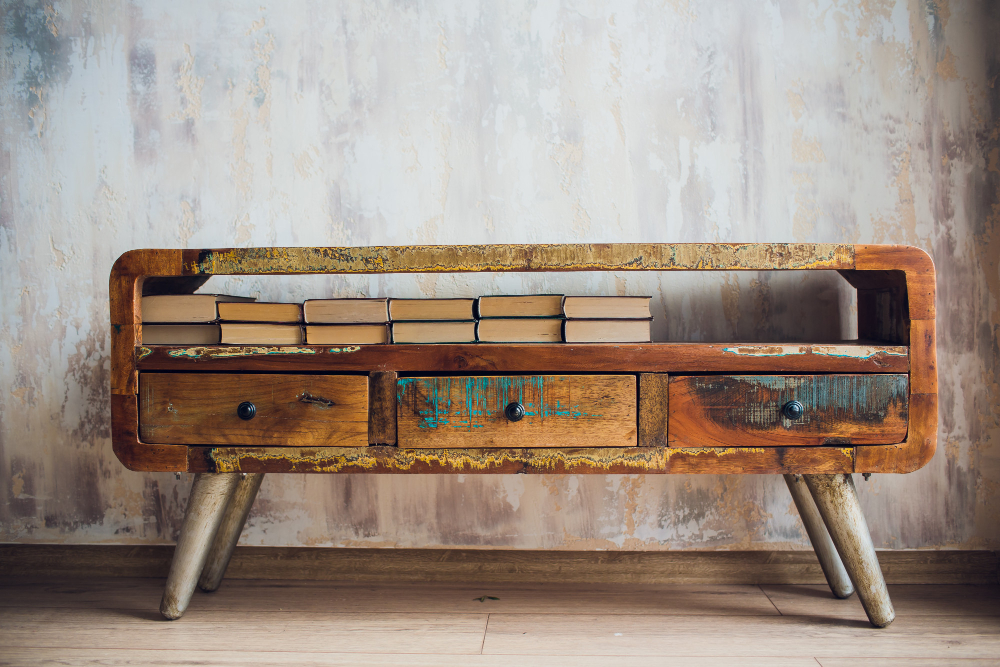Refinishing old furniture may sound tedious, but trust us; it’s worth your time and effort.
It breathes new life into your old, tired furniture and is a sustainable way to refresh your living space without spending a fortune on brand-new pieces.
Of course, you’ll need the right tools and materials to get started.
Sandpaper, paint stripper, primer, and topcoat are just a few essentials you’ll need to collect.
And, as with any DIY project, it’s crucial to keep safety precautions in mind.
Adequate ventilation and protective eyewear are must-haves in your refinishing toolkit.
But don’t let the prep work intimidate you–refinishing old furniture can be a fun and fulfilling project that you’ll be proud to show off in your home.
So grab that old dresser hiding in your attic, and let’s start giving it a new lease on life!
Preparation: Get ready to Jump in
Before you create a masterpiece out of your old furniture, you must prepare it properly.
You don’t want to end up with a shoddy job, do you?
Firstly, cleaning the piece is imperative.
Unless it has that old-as-time, rustic feel, you’ll want to thoroughly clean it to make it as good as new.
Then comes the task of removing the old finish.
Ugh.
Just the thought of it is enough to make one shudder.
Removing the finish is important as it helps the new coat adhere better, giving you a near-perfect finish.
Depending on the furniture, there are different methods of removing a finish.
You can choose from sanding, stripping, or using a heat gun.
A crucial step here is to wear the proper safety gear.
You don’t want to damage your eyes or inhale any toxic fumes.
A mask, goggles, and gloves are essential to protect your skin and eyes.
Once you’ve removed the old finish, it’s time to prepare the surface for the new finish.
This step involves sanding the surface to smooth out scratches, dents, or other imperfections.
A smooth surface ensures the final finish looks its best.
But don’t go overboard with the sanding, as it can remove the natural texture and character of the furniture.
Now that you’ve prepped the old furniture, it’s time to move on to the fun part – the selection and application of the finish.
Selection of Finish
Before we get into the details of applying a finish, let’s talk about the types of finishes available and how to select the right one for your project.
Several finishes are available, including oil-based finishes, water-based finishes, lacquer, and shellac.
Each finish has pros and cons, so considering the look and durability you’re after before committing to one is worth considering.
Oil-based finishes are known for their durability and wear and tear resistance, although they require a longer drying time.
On the other hand, water-based finishes dry faster and produce less odor but may not provide the same level of durability.
Lacquer is a popular option for its quick drying time and durability but it can also be prone to chipping and scratches.
Shellac is easy to apply and dries quickly, but it might not be the best option for frequently used surfaces.
When choosing the right finish, it’s essential to consider the level of wear and tear the furniture piece will endure.
Also, consider the aesthetic appeal you’re after.
A glossy finish might look great on some pieces, while a matte finish might work better on others.
So, take the time to assess your needs and carefully consider your options before making the final choice.
After all, selecting the right finish is the key to achieving a professional-looking project that lasts.
Application of Finish
Applying the finish is the moment of truth for your DIY furniture project.
All the hard work of preparation and planning comes together in this final step.
Here’s what you need to know to get it right.
Before you begin, make sure your finish is well-prepared.
This means straining it to remove lumps and then stirring it thoroughly to ensure a homogeneous texture.
As you stir, avoid whipping air bubbles into the finish, which can ruin your final product.
When applying the first coat, keep a light touch.
Apply thin coats, building up to the desired thickness gradually.
Be careful not to use too much pressure and keep your strokes consistent.
Don’t worry if your first coat looks rough; it will be smoothed in the following steps.
After each coat, be sure to sand and clean the surface thoroughly.
This will ensure that each subsequent coat adheres well and dries evenly.
Being patient during this step is essential, so don’t rush it by skipping any sanding.
When you’re ready to apply subsequent coats, repeat the same process you used for the first coat.
Keep the pressure light and even, using consistent strokes throughout the surface.
By the second or third coat, your surface should start looking smoother and more even.
Remember to be patient, take your time, and don’t rush this step.
Rushing can lead to imperfections that can ruin your project.
By carefully applying and sanding each coat, you’ll have a beautiful, professional-grade finish that will bring out the best in your DIY project.
With those steps done, you’re almost ready to sit back and marvel at your beautiful handiwork.
But first, you’ll need to consider touch-ups and hardware.
And, of course, those all-important final touches will make your DIY project shine.
Touch-Ups and Repairs
Ah, Touch-Ups and Repairs.
Every refinishing project is bound to have some rough spots that must be addressed.
Luckily, with some elbow grease and patience, you can quickly fix any damage and bring your furniture back to life.
Firstly, let’s talk about filling gaps and holes.
These imperfections are common in older furniture, but don’t let them deter you!
Start by cleaning out any dust or debris from the area.
Next, use a filler that matches the color of your furniture to fill the gap or hole.
Allow the filler to dry thoroughly before sanding it to create a smooth surface.
Now, on to repairing surface damage.
Scratches, dings, and water stains are common issues that can be fixed with simple steps.
First, sand the damaged area lightly to create a smooth surface.
Then, use a similarly colored filler to fill any scratches or dings.
Finally, sand the area again and apply a coat of finish.
Matching color and finish is an essential step when it comes to touch-ups.
Ensure that the new filler blends in seamlessly with the surrounding surface.
Testing your finish on an inconspicuous spot is a trick to accomplishing this.
This method can also be used to blend in touch-ups.
Lastly, let’s talk about blending in touch-ups.
Once you’ve filled gaps, repaired the damage, and ensured that the color matches perfectly, blending everything in is time.
Sand the entire surface lightly to create a smooth, even finish.
This will ensure that any touch-ups you’ve made will be virtually invisible!
And there you have it!
Four essential touch-up and repair steps to give your old furniture new life.
Remember, patience is vital when it comes to refinishing furniture.
Take your time, and you’ll be rewarded with a beautiful, unique piece you can be proud of.
Hardware
So, you’ve dedicated much time and effort to refinishing your furniture, but don’t forget about the hardware!
Even the best-refinished piece will look shabby if sporting old, rusty hardware.
Replacing hardware is a fantastic way to give your furniture a new look.
Whether updating the look with a modern finish or restoring the original hardware, it’s a quick and easy way to elevate the furniture.
Just make sure that the replacement hardware you choose fits the existing holes.
Otherwise, be prepared to drill new ones.
Cleaning and polishing existing hardware is another option.
And let’s get real here- sometimes, we all need to conserve a little effort.
With the proper technique, you can breathe new life into your hardware.
Use baking soda and elbow grease to remove the tarnish or a more straightforward approach with a polishing cloth.
Whether you choose to replace or restore, you’ll be happy to see how hardware can be the perfect finishing touch for your newly refinished furniture.
Happy DIY-ing!
Finishing Touches
Ah, you thought you were done, didn’t you?
Not so fast.
This is where the magic happens.
This is where you take your refinishing game to a whole new level.
Creating distressed finishes is a great way to add character and charm to your furniture.
You can achieve this look using special distressing tools or techniques, or take a hammer or sandpaper to the surface and let your inner artist take over.
Adding decorative touches is another fun way to personalize your project.
You can stencil patterns, create designs, or even add fun knobs or hardware to make your piece pop.
Now, it’s time to seal and protect your masterpiece.
This is a crucial step to ensure your hard work lasts for years.
Use a clear sealant or topcoat to protect the finish, and follow the manufacturer’s instructions for best results.
Congratulations!
You’ve officially become a refinishing pro.
It’s time to sit back and admire your work.
Don’t be surprised if your friends and family also ask you to refinish their old furniture.
Happy DIY-ing!
Conclusion
Finally, you’ve made it!
Your old furniture now looks brand new, and it’s all thanks to your hard work and determination.
Take a moment to bask in the glory of your DIY victory and appreciate the fruits of your labor.
Not only have you saved money by not buying new furniture, but you’ve also gained a sense of satisfaction and pride that can’t be bought.
Plus, you now have furniture that perfectly fits your style and decor.
So go ahead, sit back, and enjoy your newly finished furniture.
Remember, the satisfaction of DIY is unmatched!

